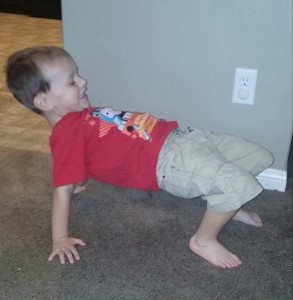I have a great fondness for Thanksgiving. While I do decorate my house somewhat for Halloween, I can’t wait to get out my cornucopias, turkey pillows, gourd candles, and pilgrim dolls in anticipation of this great holiday. So obviously I love to teach my grandsons about Thanksgiving with books and other multiple intelligence activities. I have done blog posts on Thanksgiving books before, but this year I chose some different books from the local library and planned activities for the grands: Tigger (8), Kona (6), and Tahoe (4).
While I will use the books as the “center” of this unit study, I will include activities so that all eight intelligences are incorporated sometime during the course of the unit. Since I have more time with Tahoe, he will have more opportunities to participate in a larger variety of activities. (Tigger and Kona have school and homework, so they may not have a chance to do as many activities.) I will include pictures as we complete some of the these activities. Within this post, I will also mention any academic focus I plan on integrating into any of the activities.
During the past two years, I have written other Thanksgiving blog posts featuring different books than are mentioned here. If you would like to read these blogs, they can be found here:
Linguistic Intelligence (Word Smart)
Read and discuss books- I normally get my books from the library. I always discuss the pictures, captions, and any new vocabulary as I read along with the grands, but I have an additional academic focus for each book as well:
Nonfiction: Thanksgiving by Ann Heinrichs is actually a combination of historical background, poetry, and activities for children about Thanksgiving. Some of the poems included in the book are “Thanksgiving Comes Again,” “The Pilgrims Came,” “At Grandma’s House,” and “Over the River and Through the Wood.” The book has whimsical illustrations as well. Since this is a non-fiction book, it additionally includes text features such as a Table of Contents, Glossary, and Index. Academic focus: Rhyming–As I read the poems to the grands, I will have them identify the rhyming words. Text Features: Besides showing the grands the Table of Contents, Glossary, and Index, I will model for them how I would use the index to find certain topics within the book (such as the location of the poems, information about corn, the Plymouth Colony etc.) Thanksgiving by Lisa M. Herrington and A Short History of Thanksgiving by Sally Lee are both good books to provide basic Thanksgiving information about this holiday. They contain great photographs or illustrations that help explain the first Thanksgiving and how this holiday is celebrated today with parades, family dinners, and serving others. The last two books are easy enough for both Kona and Tigger to read aloud. Academic Focus: Compare and Contrast–How was the first Thanksgiving celebrated. What is similar and/or different about how we celebrate Thanksgiving in the present?
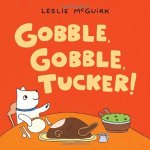 Fiction: Gobble, Gobble, Tucker! by Leslie McGuirk tells the story of Tucker, the dog, who can tell just by the smell of a baking turkey that it is Thanksgiving. He loves hanging out around the kitchen where everyone is getting ready for the meal. Tucker is very helpful, as well, by keeping nearby in case someone drops some food. When visitors arrives he greets them and they give him belly rubs. His family doesn’t forget Tucker when they sit down to eat; he is given his own feast of yummy Thanksgiving food. This is the book that the grands wanted me to read over and over to them. Academic Focus: Details–I’ll have the grands give me a few details from the story.
Fiction: Gobble, Gobble, Tucker! by Leslie McGuirk tells the story of Tucker, the dog, who can tell just by the smell of a baking turkey that it is Thanksgiving. He loves hanging out around the kitchen where everyone is getting ready for the meal. Tucker is very helpful, as well, by keeping nearby in case someone drops some food. When visitors arrives he greets them and they give him belly rubs. His family doesn’t forget Tucker when they sit down to eat; he is given his own feast of yummy Thanksgiving food. This is the book that the grands wanted me to read over and over to them. Academic Focus: Details–I’ll have the grands give me a few details from the story.
 Grace’s Thanksgiving by Lisa Bullard is another one of those books that is a combination of fiction and non-fiction. Grace is getting ready for the Thanksgiving holiday by creating a “Thankful List.” The story about Grace and her family celebrating Thanksgiving is fictional, but the story is interspersed with information about this holiday, including other types of harvest feasts around the world and how Thanksgiving became a national holiday in the United States. The book includes directions for making “Turkey Cookies” and a glossary. Academic Focus: Sequencing–What are the events that occurred that led to Thanksgiving becoming a national holiday?
Grace’s Thanksgiving by Lisa Bullard is another one of those books that is a combination of fiction and non-fiction. Grace is getting ready for the Thanksgiving holiday by creating a “Thankful List.” The story about Grace and her family celebrating Thanksgiving is fictional, but the story is interspersed with information about this holiday, including other types of harvest feasts around the world and how Thanksgiving became a national holiday in the United States. The book includes directions for making “Turkey Cookies” and a glossary. Academic Focus: Sequencing–What are the events that occurred that led to Thanksgiving becoming a national holiday?
 Over the River and Through the Wood: The New England Boy’s Song about Thanksgiving Day by L. Maria Child and illustrated by Matt Tavares is one of those books that I think I will purchase for the grands because it is a book that I would love to share with them every Thanksgiving. Besides providing the wonderful verses of this traditional song, including some verses with which I was unfamiliar, the illustrations are magnificent! This book also is part of the Musical Intelligence since I will use it to teach the grands this song. Academic Focus: Rhyming–This is another great book to use to model or practice rhyming skills.
Over the River and Through the Wood: The New England Boy’s Song about Thanksgiving Day by L. Maria Child and illustrated by Matt Tavares is one of those books that I think I will purchase for the grands because it is a book that I would love to share with them every Thanksgiving. Besides providing the wonderful verses of this traditional song, including some verses with which I was unfamiliar, the illustrations are magnificent! This book also is part of the Musical Intelligence since I will use it to teach the grands this song. Academic Focus: Rhyming–This is another great book to use to model or practice rhyming skills.
Turkeys We Have Loved and Eaten (and Other Thankful Stuff): Junie B. Jones #28 by Barbara Park tells the hilarious story of a classroom of first graders who are trying to write a “Thankful List” for a school contest and get ready for a Thanksgiving feast. I was able to find this title as an audiobook and we listened to it as I drove my grandsons home from school. Some parts of the book are “laugh out loud” funny and I enjoyed listening to the grandsons crack up over some of the dialogue in the story. Academic focus: Humor–The grands and I discussed the humor in the book and why certain parts of the story are funny.
Logical/Mathematical Intelligence (Number/Reasoning Smart)
Incorporating Other Activities: I like to incorporate math into the other activities we do with this unit.
- For example, I will ask the grands to count the number of times we had to wind the yarn around one of the Yarn Sticks (see Spatial Intelligence). Counting practice is good for both Tahoe and Kona, but I would ask Tigger, who is in third grade, to figure out how many times we would have to wind yarn on one stick. Then I would show him it’s easier if you break the problem into smaller sections, such as how many turns of yarn is needed for one inch (have a ruler handy). Hint: the yarn’s thickness might match the 1/16 width or 1/8 width on the ruler to make the estimation easier to visualize. From there he can multiply the length of the stick by his one inch estimation (how many turns or winds for three sticks of equal length?).
- Another idea would be to estimate the length of yarn needed to completely cover a stick. I would give each grand their own stick and have them cut out a piece of yarn to the size they think would cover the stick. I would probably have both Kona and Tigger measure the length of yarn in centimeters as well. Finally, they would use the yarn they cut to cover their stick and see how well they estimated the amount of yarn they would need.
Musical Intelligence (Music Smart)
- Using the book (see Linguistic Intelligence) about the song “Over the River and Through the Wood,” I will teach the grands a few of the verses.
- I will also have the grands listen to/learn these hymns: “Come, Ye Thankful People, Come,” “For the Beauty of the Earth,” and “Praise God, from Whom All Blessings Flow.”
Naturalist Intelligence (Nature Smart)
Cooking with Cranberries: I will have the grands make whole berry cranberry sauce using fresh cranberries, sugar and water. The recipe is simple:
- Place 1 cup of water and 1 cup of sugar in a large saucepan. Bring to a boil.
- Empty the contents of a 12 ounce bag of fresh cranberries into the saucepan.
- Continue to boil gently for about 10 minutes, stirring occasionally.
- Cool at room temperature and refrigerate until you are ready to serve it.
Other variations of this recipe can be found at: http://www.oceanspray.com/Recipes/Corporate/Sauces,-Sides-Salads/Fresh-Cranberry-Sauce.aspx
Spatial Intelligence (Picture Smart)
 Drawing: When asking my grandsons to draw pictures, I have often heard from them, “But I don’t know how to draw a….” so I often find books or online videos that provide simple directions on drawing familiar items. I happened to find the book How to Draw: Thanksgiving Things at the library and have used it to help my grandsons gain some drawing skills. Tigger has enjoyed drawing items from the book, while Tahoe prefers drawing from step by step videos I found online. I used some of these drawing for the Centerpiece project explained below.
Drawing: When asking my grandsons to draw pictures, I have often heard from them, “But I don’t know how to draw a….” so I often find books or online videos that provide simple directions on drawing familiar items. I happened to find the book How to Draw: Thanksgiving Things at the library and have used it to help my grandsons gain some drawing skills. Tigger has enjoyed drawing items from the book, while Tahoe prefers drawing from step by step videos I found online. I used some of these drawing for the Centerpiece project explained below.
- Tigger preferred using a book with step by step instructions to draw some Thanksgiving designs.
- Tahoe used a video to create his drawings.
- Tahoe’s drawing #1
- Tahoe’s drawing #2
Craft projects: The grands love to do art projects, and I love to decorate for Thanksgiving, so I try to choose projects that can be used to adorn the house for the holiday.
Yarn Sticks: For the first project, I bought multi-colored yarn and had my grandsons find sticks (which also makes this part of the Naturalist Intelligence). The grands wrapped the sticks with the yarn, using glue to keep the yarn from unraveling. I happened to find a nice wine basket and decorative autumn leaf piece on clearance at our local craft store. I placed the sticks and autumn leaf piece in the wine basket to make a nice door hanging for Thanksgiving. I got the original idea for the Yarn Sticks from this blog: http://babbledabbledo.com/easy-crafts-for-kids-yarn-sticks/
- Tahoe needed a little help wrapping the yarn around a stick.
- These are the first three sticks that the grands completed.
- This little autumn piece of foliage was on clearance at the local crafts store.
- I also found this wine basket on clearance at a craft store.
- This is what the door hanger decoration looks like with three wrapped sticks. The grands will be making more to add to this basket.
Centerpiece: I used the ideas from the yarn sticks and drawings my grandsons had created to decorate an old terracotta pot we had at the house. First Tigger cleaned up the pot. Then Kona wrapped yarn around the “lip” of the pot. Then I took some of the grands drawings (I had to reduce some of them on the copier to make them fit the pot) and decoupaged them on the pot. I added a colorful plant to the pot to complete the centerpiece.
- Tigger cleaned the terracotta pot.
- Tahoe brushed on Mod Podge in the area where his drawings would go.
- After placing his drawings on the pot, he sealed the pictures by brushing on some more Mod Podge.
- Kona added Mod Podge to the lip of the terracotta pot.
- Then Kona wrapped yarn around the lip and the sealer kept it in place.
- I added a colorful mum to the pot to complete the centerpiece.
Interpersonal Intelligence (People Smart)
Thankful for Family: This is something that the family already does before the Thanksgiving dinner, but I want the grands to think about this more frequently. Whether they are eating breakfast, lunch, or dinner, asking each grand to describe how they are thankful for members of the family is a great way to remind the grands that family is very important in their lives.
Dramatic play: I will engage the grands in some dramatic play in which they dramatize the first Thanksgiving. This will tell me how much they have learned from all the books we have been reading about the beginnings of this holiday.
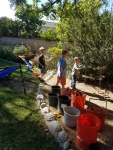 Bodily-Kinesthetic Intelligence (Body Smart)
Bodily-Kinesthetic Intelligence (Body Smart)
“Turkey” Horseshoes: This is somewhat similar to playing “Horse” with a basketball, but the object of the game is to spell “turkey” and it uses horseshoes instead. I will have the grands take turns throwing a horseshoe (can be plastic) at a post from a certain distance, determined by their ability. Each grand gets one throw per turn. They can add one letter from the word “turkey” each time they are successful in landing the horseshoe around the post. I want the game to continue until each grand has had the chance to spell out “turkey.”
Intrapersonal Intelligence (Self Smart)
- Thankful List: After reading these books, I will have the grands create their own individual “Thankful List.”
- I leave the library books in a convenient place for the grandsons so they can browse or read them on their own.
I hope you are finding these Multiple Intelligence activities useful as you plan lessons for children in your care. If you would like to see more of these unit studies as I create them, you can become a follower of this blog.
I love to add my blog posts to link parties such as:
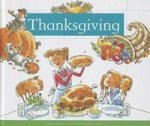


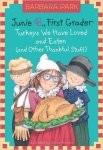
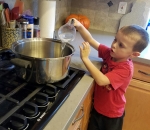

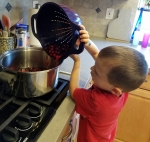

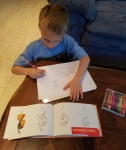
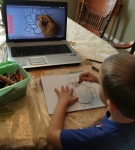

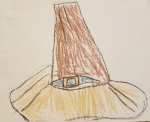
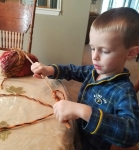


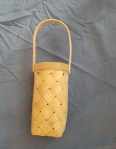


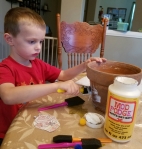



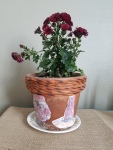
















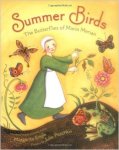

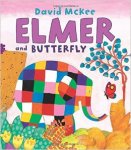
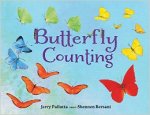

















































 nice for younger children interested in matching the fallen leaves with their trees. It has lovely illustrations.
nice for younger children interested in matching the fallen leaves with their trees. It has lovely illustrations.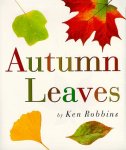
 o Leaves Change Colors by Terry Allan Hicks is a non-fiction book that is full of scientific explanations, photographs, and an activity for older elementary aged children. It was a wonderful resource book for me, and I did read a few pages to my grandsons and show them the illustrations. However, the grands weren’t ready to have the entire book read to them, even though it is only 30 pages long.
o Leaves Change Colors by Terry Allan Hicks is a non-fiction book that is full of scientific explanations, photographs, and an activity for older elementary aged children. It was a wonderful resource book for me, and I did read a few pages to my grandsons and show them the illustrations. However, the grands weren’t ready to have the entire book read to them, even though it is only 30 pages long.







































